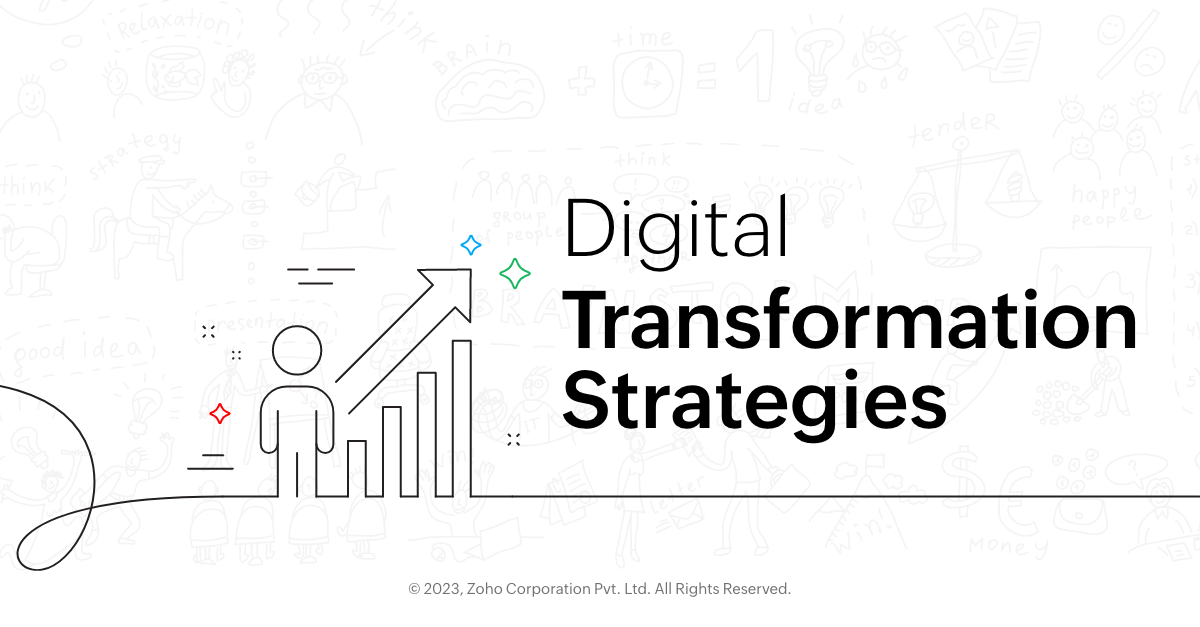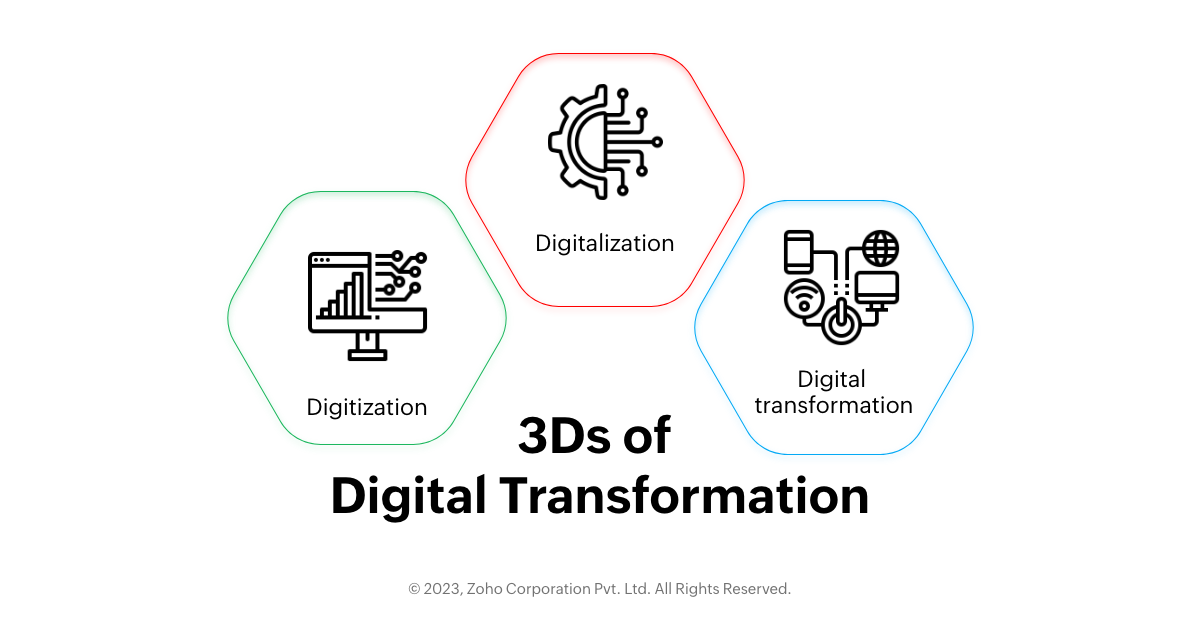- HOME
- Know Your Tech
- Going Digital - The 3 Ds to digital transformation
Going Digital - The 3 Ds to digital transformation
- Last Updated : August 22, 2023
- 1.6K Views
- 6 Min Read
Go digital or go home
The ongoing digital shift in the business world is taking place at a scale and speeds never seen before. With a considerable chunk of employees now working remotely, digital technology has gone from "good to have" to "the only way to get work done."
As such, many companies have chosen digital transformation as part of their competitive strategy. However, despite being interested in innovative digital technologies and appreciating their necessity, many businesses are still speculating, and have yet to begin their digital transformation journey. There's still uncertainty among companies around how to leverage these technologies to create a sound digital transformation strategy. It's likely that some of this uncertainty lies in the terms that we use when discussing the concepts and benefits of digital transformation. With this blog, we're attempting to make the language of digital transformation more approachable and, hopefully, less buzzwordy.

Why differentiating DX terms matters
It's crucial to get the nomenclature right when discussing technology that is constantly in flux and rapidly evolving. The terms“digitization,” “digitalization” and “digital transformation” (DX) are becoming increasingly common, and often used interchangeably.
Consequently, their exact meaning sometimes gets lost, creating silos or laying too much focus on one aspect of business problems. For example, it's easy to mistake the presence of digital information and processes for digital transformation.
Endeavors to make data and processes digital (often loosely referred to as digital transformation) may trigger or contribute to the process of digital transformation, but by themselves, are not digital transformation.
An exploration of the differences can help create a better understanding of significant benefits of digital transformation.
What is digital transformation?
Digital transformation, in simple terms, is defined as "a company's adoption of digital technology to improve business processes, increase value for customers, and innovate." Digital transformation involves a strategic, coordinated effort aimed at fully leveraging the opportunities provided by digital technologies for value proposition in business activities, processes, and models.
A digital business transformation strategy is about finding new possibilities to enhance business leaders' interactions with employees and deliver better customer experiences.
Digitization, digitalization, and digital transformation: Decoding the concepts
Digital transformation is a universal set comprised of two subsets—digitization and digitalization. It would be easier to say that digitization, digitalization, and digital transformation are the 3 stages to digital "enlightenment" and complete digital adoption.
Digitization
We digitize data. Digitization is the task of converting data from an analog to a digital form. For example, we digitize paper records and store them online for archiving and retrieval.
Digitalization
We digitalize processes. Digitalization describes using digital technologies and information to transform individual business operations. For example, we digitalize payroll, procurement, supply chain management, and administrative operations.
Digital Transformation
We digitally transform businesses. Digital transformation is a business strategy to improve a company's strategic direction or value proposition by leveraging digital technologies. Digital transformation involves organized shifts in culture, workforce, and technology.
In summary, organizations undergo significant digitization and digitalization work en route to successful digital business transformation. While digitization is compulsory for the strategy of digital transformations to move forward, it is digitalization that shows commercial impact with process automation and operational efficiency, finally reaching the ultimate stage of digital transformation at the organization level—as a business that makes money off digital tech.
Know-how for digital transformation
Digital transformation, just like any other business strategy that uses customer-centric marketing and processes, requires the ability to work across silos. In many cases, digital transformation can even be about totally reworking organizational structures using collaborative methods.
Before engaging in a DX skillset debate, it's essential to know that there is no "one size fits all" regarding expertise. However, at a high level, the workforce driving a successful digital transformation initiative in an organization needs some essential prerequisites to gain a competitive edge:
Digital Proficiency
Automating business processes can be a double-edged sword. In an ideal world, every company should have its business processes organized and automated. But in reality, that is far from the truth, and most new business models and operation structures haven't been regulated yet.
So the first challenge to define digital transformation would be identifying what processes and data can be digitized and digitalized, and then replicating them in a digital format. Choosing the right technology, software, or device for the transformation becomes difficult if employees lack digital literacy.
The digital technology landscape is constantly evolving, and outdated legacy solutions are quickly becoming obsolete. It's necessary to make sure employees stay on top of these digital age trends.
Data Proficiency
Data analysis can be an invaluable tool to help a business spot areas of weakness and capitalize on its strengths. Digital transformation drivers shouldn't be making decisions, formulating policies, or uncovering strategies based on intuition alone. Meaningful, accurate data insights fuel effective decision-making. These insights can't be drawn by simply looking at vast volumes of raw data.
Businesses can benefit from the expertise of personnel who can analyze crucial data, disregard vanity metrics, and draw meaningful business insights, to be acted upon. This is vital to communicate and manage expectations for digital transformation initiatives within the company, and to external shareholders.
Design Proficiency
Driving innovation in an organization is more than just an integration of technology. It's also about adopting a strategy to innovate business processes and reevaluate the value delivered to customers. Adequate design literacy can significantly contribute to the advancement of digital transformation strategies.
Design thinking is a human-centered approach. It has collaborative, action-oriented processes and techniques to help understand market signals better and get insights about changing customer preferences. Design thinking is popular with companies interested in driving digital transformation from within. Design thinking is made up of five steps: empathize, define, ideate, prototype, and test.
Organizations must be agile and innovative as they integrate digital technologies into their own business models and practices. For businesses looking to compete in a digital world, expertise in design thinking is vital.
Explore more about digital transformation in this detailed guide.
The significance of digital business transformation
Digital transformation initiatives cannot help with establishing the purpose of a business. However, digital technologies can help reshape an organization's perception, data insights, awareness, and ability to take collective action. The bigger picture, beyond merely digitizing records and digitalizing operations, is how technology equips companies for the modern business landscape. From a holistic view, digital transformation efforts can:
- Position organizations to become agile businesses that swiftly respond and adapt to changes in consumer and employee expectations.
- Help reach beyond the traditional boundaries of an organization, with digital ecosystems that give access to data from a broader business landscape.
- Extend the senses of the organization so they can learn and act at algorithmic speed with advanced AI.
- Close the skill gap with connected digital learning loops that force digital learning in team members.
- Create customer-centric business strategies using relevant, personalized, and agile content.
- Delegate and automate routine tasks to algorithms, so that humans can focus on exploring new possibilities.
- Facilitate communication and cooperation between people to scale and accelerate collective organizational action.
- Diagnose system health and overcome core business incompetencies with business process reengineering.
Main digital transformation trends in the modern era
AI and machine learning.
Personalizing customer experience.
Public cloud adoption and connected clouds (public, private, hybrid)
Customer data platforms
Quantum computing
5G
Data analytics
Internet of things
Connected supply chains
Remote work
Contactless solutions and digital payments
Reshape your digital transformation strategy
Digital adoption plans can't be one-size-fits-all. Organizations must set their budget and pace based on industry and business specifics. A custom approach seems to work best with the strategy being a gradual progression to new digital tools and ways of operating.
As stated earlier in this blog post, the three Ds have different goals. While digitization and digitalization are essentially about innovative technology, digital transformation is not. Digital transformation is about people.
To come out ahead, it is important to start by building a customer and employee-centric culture that's backed by innovative tech. Transformation success in customer journey is more likely when organizations have invested in digital talent and developing digital skills throughout the organization.
The more agile your workforce, the better your business can reshape to address new digital transformation challenges, offer quality products and services, keep customer satisfaction and stay ahead of the competition.
 Rashmi Sasi
Rashmi SasiProduct marketer at Zoho Creator, where she researches and creates content about all things low-code. Writer by day, reader by night, into eclectic books and long sentences, sci-fi enthusiast, and novice painter. Dislikes character limits.



